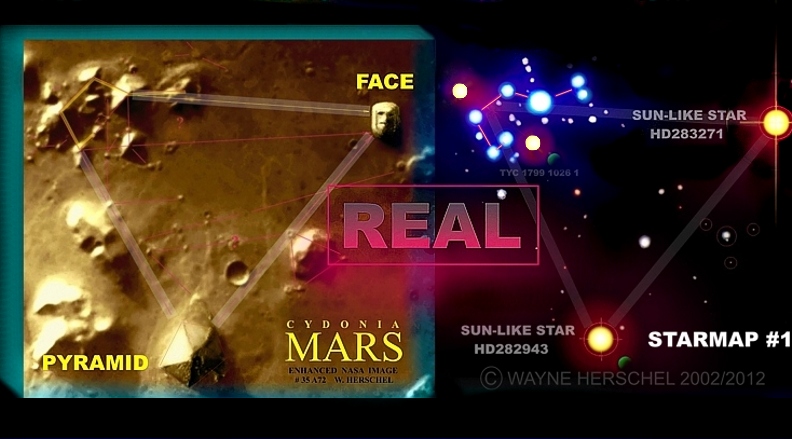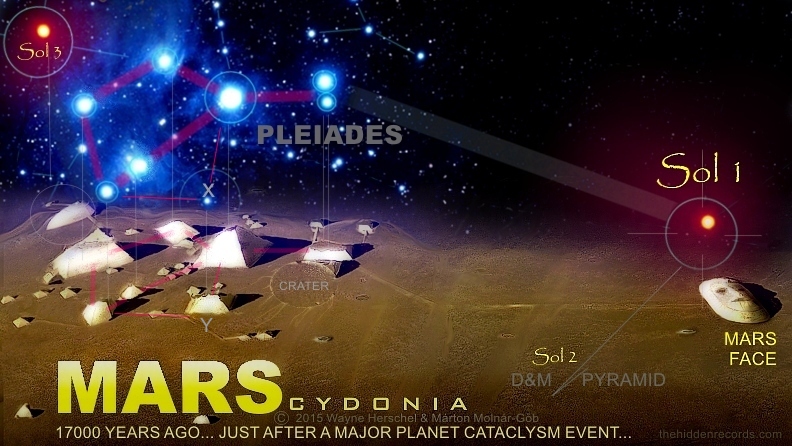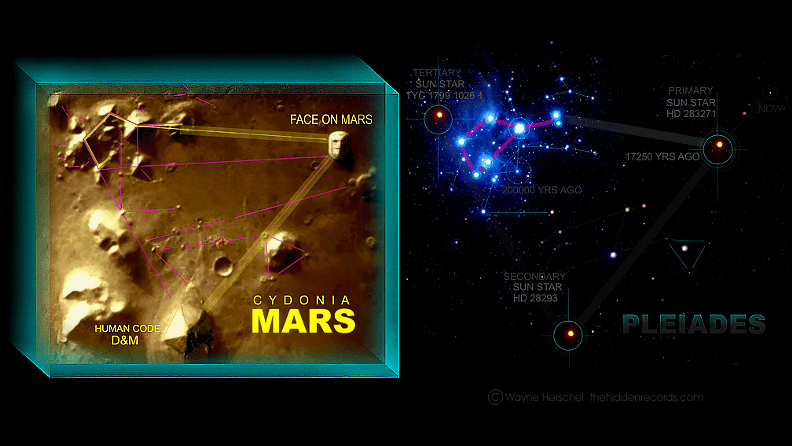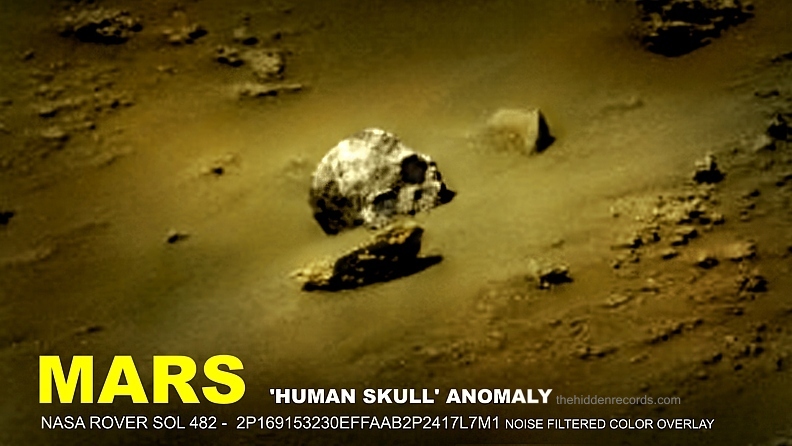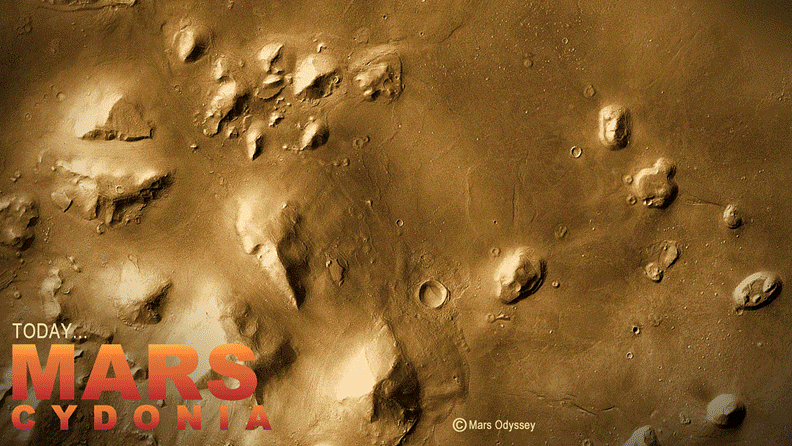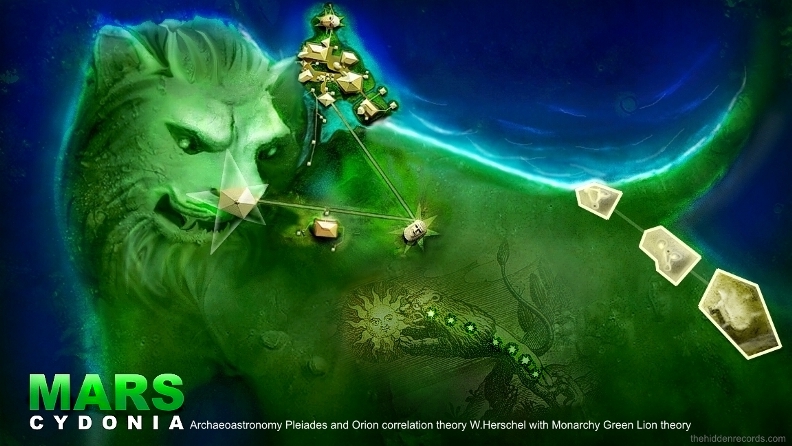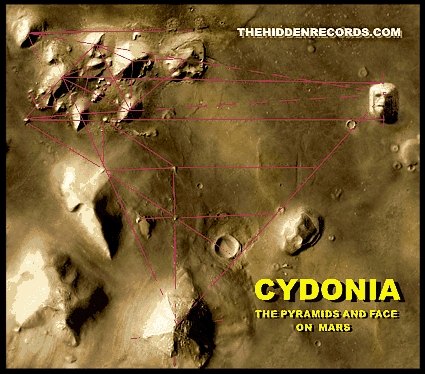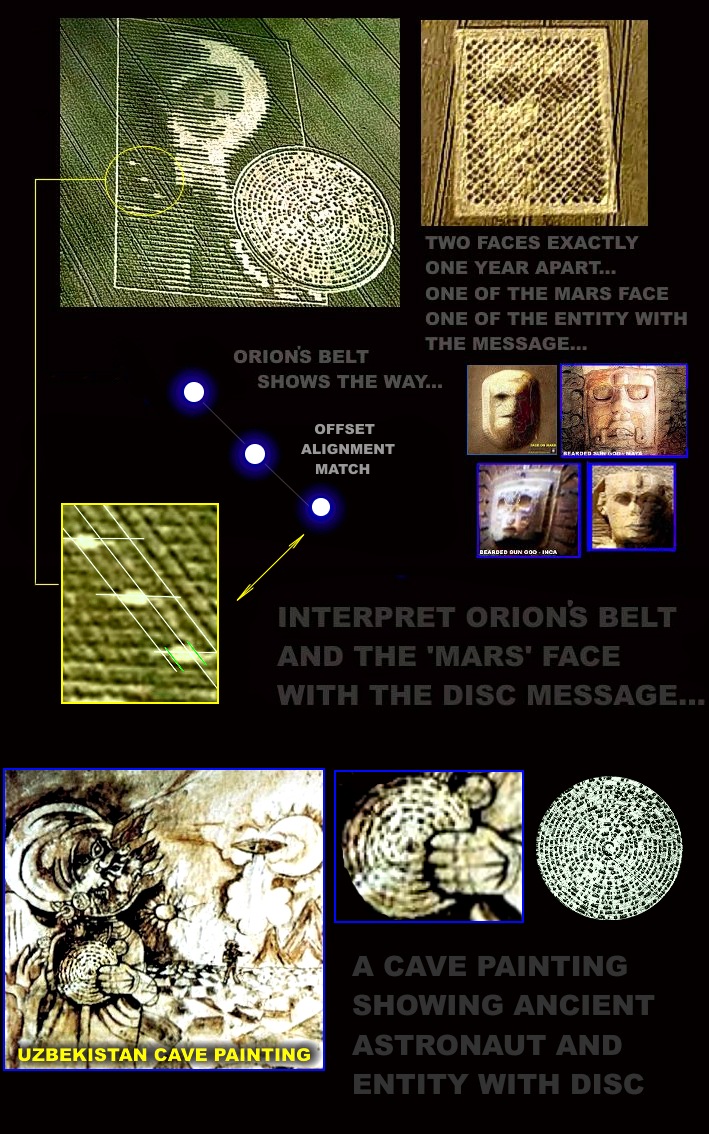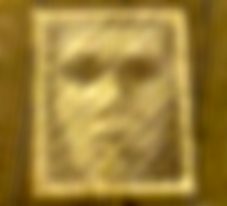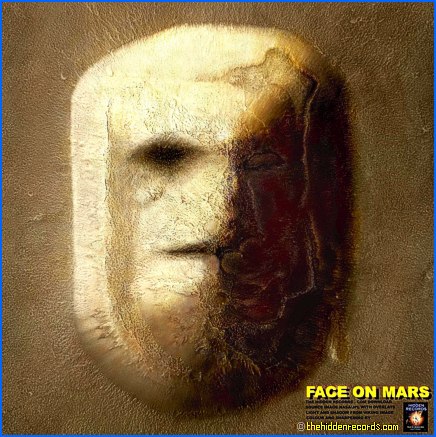Before exploring the ultimate pyramid star map evidence of my Pleiades star 'gods' theory... or the latest exciting new discovery massive levels of methane proving microbial life - a breaking new composite overlay image of the Mars Face has just been released (image seen above - Jan 2009) with the highest resolution ever and with the correct light angle producing a 3D perspective. The evidence you are about to explore on this page will no doubt make this website one of the leading research sites on the internet in archaeoastronomy and the subject of the Mars pyramids of Cydonia. This web page presents in advance of my next new release or ebook, as a preview of all the latest 'measurable' findings that authorities are still not prepared to comment on yet. The findings that follow will convincingly prove that the anomalies on Mars were not only built by advanced life… but built perhaps by our very own ancestors.
The most convincing and strongest case, proving the existence of advanced intelligent life on Mars, is right here: The blocks found on the Mars Face (above). The image here is of the Face of Mars showing various block/sand debris patterns, all of which match pyramid ruins in Egypt partially covered by sand. (Story follows). From the image you will see from the extended lower part of the face, it was once perhaps originally the face of a bearded human. The case made for the Red Planet once having had advanced intelligent life on it can be further corroborated by what appear to be pyramids on its surface, with their layout plan matching the layout plan of the layouts that all the pyramid civilisations here on Earth are based on, namely a very specific star formation in the night sky. From the recent discovery (bottom of page) that Mars once had oceans like Earth, to finding moss or algae and remains of a remarkable fossil on Mars... they all present strong cases for life once having existed on this planet. But the most controversial finding of all has to be what appear to be the remains of a human space helmet. What is more, it seems to be the same style as that of one used by a prominent secret society here on Earth and that was emulated in one of the most famous space science fiction movies of all time.
The first ever high resolution image of the face on Mars was made available two years ago by NASA JPL through the HIRISE PROJECT at The University of Arizona but the image was so large that computers in 2007 were either unable to complete the download or simply open it before it would crash them. Since then, the image has been unrecognised for its real value and almost forgotten. But technology has recently caught up with handling large images, and my two-year project of careful image processing has now been completed.
The image above (and 4meg image) shows many different block patterns matching pyramid ruins in Egypt covered in ‘The Hidden Records’. When sand forms over collapsed areas of pyramid ruins, very definite patterns are clearly identified. The Mars face has them all, and it is not surprising since the planet at some point in its history experienced a meteorite impact event that ended it, leaving a 2000 km wide impact crater.
The 2007 image of the Face on Mars made available to researchers was so large that even viewing it in an image window still kept crashing computers. The image was put on hold for a while. But while looking at some of features on the image before it crashed I realised a few important facts. Firstly, I noticed that there were some disappointing digital noise line patterns in a large portion of it, which would need to be painstakingly removed by hand. Sadly and as was to be expected, the whole image (a black and white gif source) was upside down and at an awkward angle, with poor lighting and poor contrast. We expected that, it seems to be the norm for important images of the Cydonia area that are released by the university website

I was absolutely ecstatic at the clear spectacular detail I was seeing for the first time. I immediately noticed what was clearly a debris field (shaded purple in the image above) revealing that the ‘nose’ had lost its tip. There was another matching debris pattern with another important portion on the Mars Face. It was perhaps the ‘x’ that marks the spot anomaly in what I am certain was once the small obelisk on the forehead, intended to correlate with a specific star if this is a star map, and which had no doubt collapsed since. This is a breakthrough on its own since the third eye positioning is part of its message and it matches themes like the greatest ever Egyptian style obelisk ever built in Egypt (as will be explained shortly), and now the scattered material in block form is there to justify it. The design would match the obelisk Sun Temple in the Egyptian pyramid field. The importance I explain in my book: The reason the Sphinx has a cobra on its forehead, and the reason other Sun god face monuments found around the world all present the same unusual square looking human face, with mouth poised open and with something in the position of the third eye.
Researches have already suggested the Mars Face experienced at least five direct impacts by meteorites (remains of five craters in shadowed section now very clear). Also they speak of a large directional planet crust shift, apparently moving suddenly to the right, during what would have been a ‘Mars-quake’ well above a magnitude 10. It would have been caused by a massive impact event, which ended all life on it. Hence the nose and forehead obelisk collapsing in the same direction (shown here by purple shaded areas). By the way… here is where the clearest examples of block debris are exposed!
There are literally millions upon millions of block-shaped ‘rocks’ everywhere. Straight edged rocks of linear sizes! There are three general sizes, the most common size is around 2m to 3m long like the blocks used to build the Giza pyramids in Egypt, followed by extraordinary examples around 5m long, like the blocks of the Sphinx temple in Egypt, and some massive examples more than 10m in length like the blocks found at Baalbek in Lebanon. In his book published in 2003 I already identified some of the largest blocks, daring to suggest at that time that the Mars face was built of blocks… and that the Face on Mars has a very definite left eye. But academics laughed at his conclusion saying I was seeing things that were not really there... tricks of light and shadow.
The time has now arrived demanding a second look, and this time a serious debate is inevitable. I knew I was able to overcome all the problems in the newly released satellite image where I could digitally overlay shades of appropriate colour found in more recent Mars images for this area.
But for me there was something more valuable that would prove the 3D value of the Mars face seen in some other more recent low resolution images. For my book I was able to master an art program to bring out the striking detail. By adding slight colour and by producing an overlay mask sourced from the 20 year old Viking image of the Mars Face, then overlay it onto a 2003 overhead sun shot I had a spectacular end result. In doing this I produced the first clear image on the face on Mars with the appropriate 3D sun angle interpretation. This was important because this ‘true’ (scientifically valid) sun angle shows the 3D nature of the anomaly, but more importantly how a human face would appear in daylight. So to achieve a scientific comparison to a 3D human face, one would need to compare the effect of natural lighting on a human face with what could be a real human face carving on Mars. In the image below the source is in black and white and the graphic shows how the image was processed and how the sun angle data altered with overlay processes to match the old Viking image. The part of the Mars face with the most apparent damage is the area of the lower mouth. The face most likely originally had an open mouth. The reasons for this are shared amoungst all ancient civilisations for this depiction of a 'Sun god' when depicted as a face. The lower lip appears to have shifted by the impact event visible on the right hand side of the mouth. The blast seems to have forced the lower lip further down.

NASA would never ever take this research approach comparing the anomaly with a human face as it would not be in its best interests to try to prove that the anomaly is an ancient monument.
In August 2008 the time arrived when a computer finally succeeded in downloading the very large image with a Coral Photoshop program. The first thing that I felt urgently needed processing while being in large format, was to eliminate unnecessary excess background to prevent the computer from crashing. I succeeded. In so doing this now guaranteed that the work could begin without any more risks of computer crashes. The image was rotated to the ‘upright face’ position and more of the background was cropped out, cutting the image down to a workable size of a 70 meg file. This was followed by a contrast adjustment enhancement simply at the click of a button. Days were spent removing 70% of the false noise lines.
Now here is where the art program excels. The secret in enhancing detail without getting pixel noise is as follows: The image was resampled again making the face bigger to 90 megs, but now the face was almost twice the size. A second smoothing feature on Coral Draw allow one to blur with a setting of 1.5 pixels softening source pixel edges. Now all the detail in the whole image was smoother, but edges of everything else more crisp. It could now be compressed and saved at a rate where block edges are preserved and a workable size of 20 megs.
I spent months on adding approximate colour tones by referencing all the latest source colour satellite images of the Cydonia area against one another. This was followed by laboriously enhancing every single obvious block shaped anomaly to make his claim clear without distortion. The process is simple and accurate. Using the sharpen function as a brush nib, it simply sharpens all chosen detail without altering its source shape. The example below shows one small portion of the source image and how it was processed. Note how accurate the enhancement and colouring is when comparing the source against the final version.
The hardest part of all was recreating the Viking original satellite image with perfect 3D light and shadow with an overlay over the the ‘flat’ image with overhead sun. The multi overlay masking of adjusted lighter areas and darker areas from the original Viking image is possible without losing the valuable block detail.
The dramatic unveiling at an expo of the 1.5m image in colour will be launched witha future event so the public can view the evidence of the millions of block patterns matching patterns seen on Egyptian pyramids.
Sensational new findings of massive quantities of water on Mars for some unknown reason have been prevented from main news media. University press releases have made their internet releases known but that is as far as it gets!
The latest findings of 1000's of kilometers of ice fragments appearing like footage seen of fragmented ice sheets on the sea in the seas around Alaska has now been officially identified. All that is different to Alaska is that the ice is covered in dust and they are absolutely massive fragments. Here is the image gallery on the website that has made these images possible. The mystery behind the giant 'splat' craters is no longer a mystery as it seem reasonable to say that some impacts hit a suddenly exposed muddy ocean floor after the cataclysmic primary impact event on Mars. An impact event that destroyed Mars creating a 2000km wide impact crater called the Hellas Basin. In the link below see the second image and question the 'real' green colour in this colour image, because scientists are saying it is more easily explained as the mineral colour of the surface. Coincidently, in this area conditions are exceptionally perfect for any algae or moss.
Look at the possibilities:
Sunlight...
Volcanic 'rich' soil...
Constant wet area...
Carbon dioxide rich atmosphere...
An image proving a green surface...
This is the best case so far in questioning the potential of moss or algae!
Link to news release: 'Frozen seas on Mars'
There is more... The ancient lake discovery released June 2009. Not as exciting as frozen oceans hiding under dust but here is a 'hidden' news release at Science Daily for the Colorado University findings on the lake discovery:
Link to Lake on Mars Discovery: 'Ancient Lake discovered on Mars'
Also frozen water permanently available in craters, perhaps of great use to the future mars landing is just as important. This finding is also not well known and especially surprising since its exciting potential making the Mars trip a lot safer with a smaller water payload demand.
Link to water available on Mars: 'Frozen water discovered in Mars crater'
The image below is sourced from ESA Mars Express and it was one taken with special colour sensitive film. There have been many green images already debunked as mass deposits of gypsum but this one is in an area far from the green deposits. This one is in an area recognised as having ancient water erosion. If a cataclysm destroyed all surface vegetation, starting off again from ground zero, it is likely algae would have survived, now forming in the favourable warmer areas and with an atmosphere rich in carbon dioxide. A thin atmosphere would also be no problem for algae. I simply lightened and enhanced colour in the second image which enhanced the soft shade of green. The green patches have also formed in a way algae or moss would form on rocks.


NASA has announced at a press conference that it can confirm a South American astronomer making the claim that massive quantities of methane gas is currently being released on Mars! NASA probably had the same data for a while from their own research but perhaps felt they were not ready to make the announcement.
How can such an important breakthrough be held back? If it weren’t for this astronomer making a claim, nobody would know about it.
The very first Viking landing probe over 20 years ago had a very expensive mini lab to process soil samples looking for carbon to prove life. They found it... BUT while the NASA research team was drinking Champagne, other scientists at NASA tried to disprove the carbon life theory completely. It is as if they don’t want people to think life is or was ever possible on Mars! The Mars Beagle probe a few years ago also had very expensive equipment on board to detect methane for one reason and for one reason only… if it could detect methane it would be able to prove micro biological life on Mars exists. It apparently didn’t work.
Now that the cat is out the bag, scientists seem more interested in disproving the possibility of life on Mars by trying to prove the only other explanation for the methane… recent volcanism and surface lava flows… something they always insisted previously was absolutely impossible. They always said Mars was a volcanically extinct planet. So much so that not only was there no existence of volcanic activity, they insist that the crust is so solid and frozen it was completely without crustal movement. All the data proved it was not like Earth at all as it is today, with our relatively thin land masses floating on magma.
The methane gas is mainly found around the warmer equatorial areas on Mars so it is more likely to be that discharged by microbial life living in the damp soil around the equator.
Only microbial life can explain these massive quantities of recent methane discharges if it is not volcanic activity. Volcanic activity would easily be detected in many ways, especially sensors reading infrared radiation. There have been Mars temperatures across the surface everywhere not much different to the average Canadian winter, and those are the warm readings. The story has already slipped away into darkness. The next finding I made now makes a lot more sense… algae or moss seen on Mars… yet no comments from NASA. News agencies around the world seem to have avoided using this valuable methane discovery in their bulletins. See the BBC release 15th Jan 2009.
The image that follows is sourced from Spirit Mars rover from NASA and it is of something that creates a whole new conspiracy theory. The unusual object here is an exact match in detail to something used in the famous Star Wars movie for a 'Storm Trooper'.
If there is any possible chance that there is a connection here it would have to have the same explanation for the 1958 story that follows here where famous authors like Arthur C. Clark and many others coincidently knew about the face on Mars by including it in their books many years before any Earth probe was anywhere near Mars. I am very hesitant in saying that if this is true then there are secret artifacts in store somewhere, perhaps something found in Egypt under the hole in the Sphinx chest area in the late 1800's that depicts the detail of the star visitors who founded ancient pyramid civilisations.
One has to wonder if George Lucas was either inspired to create his helmets for his characters like this by chance or was he inspired to replicate something only known by secret society... just speculation here. His Storm Troopers also have a face just like the viking image of the Mars face too... another Mars coincidence.
In reasoning a helmet like this, I comment as follows:
If the advanced inhabitants on Mars knew a debris field of meteorites was heading their way and they could not evacuate all its world population they would need to prepare its people with protective space suits of some sort. Those needing evacuation shortly after the cataclysmic event that ended Mars are in question here. They would have known the atmosphere would be filled with volcanic gas and dust. They would no doubt build underground protective dwellings too but the need to wear suits something like the proverbial Storm Trooper makes sense, especially body armour if meteor showers were inevitable. The two small cylinders at the bottom of the helmet would most likely be two small air filters as per our war gas masks. Their world would have been like a war zone. If any ancient artefact was ever discovered on Earth and kept secret because it depicted the last people on Mars like storm troopers, it is no wonder at all that the ancients believed Mars was linked to beings revered as gods of war! Did the little rover take a close look at this 'rock'?... Sure they did... but news on that would not be for public consumption.


Mars has produced an array of potential fossils but one stands out far more convincing than any other for a number of reasons. It is of what appears to be a sea shell and it is embedded in fossil rock that scientists found the strange round oddities that they nicknamed blueberries. In the image below colour shaded by me which was sourced by the NASA Opportunity rover - one wonders if it had a high calcium reading after it was ground to a pulp by the rover? NASA obviously claims it produced just rock dust otherwise we all would have celebrated the first official fossil discovery. Since then there have been two cases of what appear to be a bird skull and a lizard skull but due to the amount of very odd rock shapes nearby these are not strong cases.











